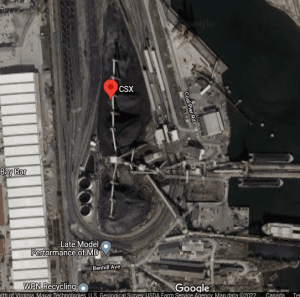
Date: December 30, 2021
Location: Baltimore, Maryland (USA)
Address: 1910 Benhill Avenue, 21226
Type: Dust Explosion
Fuel: Coal Dust
Industry: Transportation
Equipment: Conveyor Belt
Company: CSX Transportation
Database Incidents: None Recorded
Loss: No Injuries
Capital Cost: Unknown
Status: Open
Confirmation: Unconfirmed
Company Description:
According to the company website, CSX Transportation is a Class I railroad operating in the eastern United States and the provinces of Ontario and Quebec in Canada. It is headquartered in Jacksonville, Florida and operates approximately 21,000 route miles of track.
Incident Description:
On December 30, 2021, CBS Baltimore reported an explosion at a railroad facility in Baltimore, Maryland.
The incident occurred shortly after 11:30 a.m., as coal was being moved on a conveyor belt at the plant. It blew out the windows of nearby buildings and sent shattered glass everywhere. One resident reported seeing three black plumes of smoke and heard a series of explosions.
The coal facility encompassed various components, including an incoming and outgoing rail service, a railyard, a coal transfer yard, railcar unloading infrastructure, conveyor infrastructure, pier loading facilities, and associated office, maintenance, and operations buildings.
Within the facility, the coal transfer yard, situated at its center, served as a collection point for incoming coal, which was piled up. To facilitate the collection process, the coal was transferred through conveyors located at the top of stacking towers, passing down through them. Vibrating feeders mounted to openings in the yard surface enabled the transfer of coal from these piles to the conveyor system in the tunnel.
The transfer yard consisted of eight primary stacking towers, with five located on the north side and three on the south side. Between the north and south sides of the transfer yard, a central transfer tower contained conveyor infrastructure capable of diverting coal in various directions.
The explosion occurred on the north side of the transfer yard within the North Reclaim Tunnel, a concrete tunnel spanning 770 feet from north to south and positioned directly beneath the yard. It originated between feeders 7 and 17 within the tunnel. A subsequent lawsuit related to this incident stated that the explosion “likely was initiated by the ignition of a localized flammable atmosphere composed of methane released from the coal, and a relatively low concentration of coal dust made airborne by the operating conveyor, which enhanced the flammability of the released methane.”
Insufficient ventilation rates within the tunnel allowed the formation of a localized atmosphere, preventing adequate dissipation and removal of methane and coal dust. The initial combustion event produced a pressure wave that traveled in both the north and south directions along the North Reclaim Tunnel. Consequently, the quantity and density of airborne coal dust within the tunnel increased.
The coal dust, acting as fuel, sustained further combustion throughout the tunnel, including its south surface entrance and the North Escape Tunnel of the North Reclaim Tunnel. The combustion and blast pressures escalated along the length of the tunnel, resulting in the visible plume that emerged from the south surface entrance and extended beyond the facility into the surrounding neighborhood.
No injuries were reported.
Research Team Update:
In a report issued on June 29, 2022 (Inspection 1572262), OSHA cited the company for several safety violations, including failure to supply employees with respiratory equipment while working in the coal tunnels, failure to provide any documentation designating the areas within the coal terminal with the designated hazardous classified location, and failure to provide equipment approved for use or protection in a combustible dust atmosphere. In total, there were nine serious penalties covering seven items and it totalled $121,200 in penalties.
On October 18th, 2022. a group of Baltimore residents filed a class action lawsuit against the company for a total of $5 million for coal dust and debris, broken windows, and other damage. The suit, which claimed that the company was negligent because of inadequate staffing and failed to comply with permit requirements, suggested that airborne coal dust was a factor in the intensity of the explosion.
Sources:
CBS Baltimore
OSHA Inspection 1572262
Cheyenne Shongo, Kennett Walker, individually and on behalf of all other similarly situated people vs. CSX Transportation Inc., Case 1:22-cv-02684-RDB
